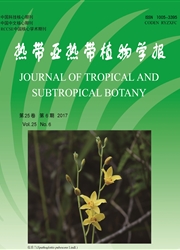

 中文摘要:
中文摘要:
在广西靖西土石山生态交错区调查了西南桦(Betula alnoides)生殖植株的生长状况,并研究土山和石山两种生境条件下西南桦的生殖构件及其在冠层的分布格局。结果表明:石山西南桦开始开花结实的林木胸径明显小于土山;两种立地上西南桦植株的花芽、花序数以及雄花序比率与其胸径、树高均不显著相关(P>0.05);土山和石山的西南桦雄花序数随着总花序数的增加均呈对数曲线增长趋势,在生殖投资较小的情况下植株趋向于优先发育雄花序,而在生殖投资较大时主要增加雌花序的数量;西南桦生殖构件在两种生境间存在显著差异,石山植株的雄花芽数、每个雄发芽发育出的雄花序数均显著低于土山(P<0.05),雄花序少于雌花序的植株比例远高于土山,生殖枝比率亦显著低于土山(P<0.05);尽管石山雄花序、雌花序和总花序数量以及雄花序比率低于土山,其雌花序比率高于土山,但是由于两种立地上单株间变异幅度大,独立t检验表明其差异均未达到显著水平;两种立地上西南桦花序大多着生于树冠上、中层,且90%以上的生殖枝居于树冠外层。
 英文摘要:
英文摘要:
Growth status of reproductive individuals of Betula alnoides were investigated in an ecological ectone of two types of soils originated from limestone (site L) and granite (site G), respectively, at Jingxi County, Guangxi, and the relationships between reproductive modules and their allocation patterns in crown layer were discussed. The results showed that the diameter at breast height (DBH) in site L were remarkably smaller than that in site G, when plants started flowering and fruit setting. The number of flower buds, total number of inflorescences and ratio of male inflorescences were not significantly correlated with DBH and plant height (P〉0.05). The number of male inflorescences increased with increment of total number of inflorescences by logarithm curve, and the trees trended to develop male inflorescences under lower reproductive investment, while mainly develop female inflorescences under larger reproductive investment. There were remarkable differences in characteristics of reproductive module between both sites, the number of male buds and number of inflorescences developed from each male bud at site L was significantly lower than that in site G (P〈0.05), the ratio of the plants with male inflorescences less than female ones was much higher than that at site G, and the ratio of reproductive branches was also significantly lower than that at site G (P〈0.05). Although the number of male inflorescences, female inflorescences, total inflorescences and ratio of male inflorescences at site L were smaller than those at site G, and ratio of female inflorescences at site L was larger than that at site G, there were no significant difference between them (P〉0.05) due to high level of variation among individuals at each site. The majority of inflorescences were on upper and middle layers of crown, and above 90% of reproductive branches occupied on the surface of crown at both sites.
 同期刊论文项目
同期刊论文项目
 同项目期刊论文
同项目期刊论文
 期刊信息
期刊信息
